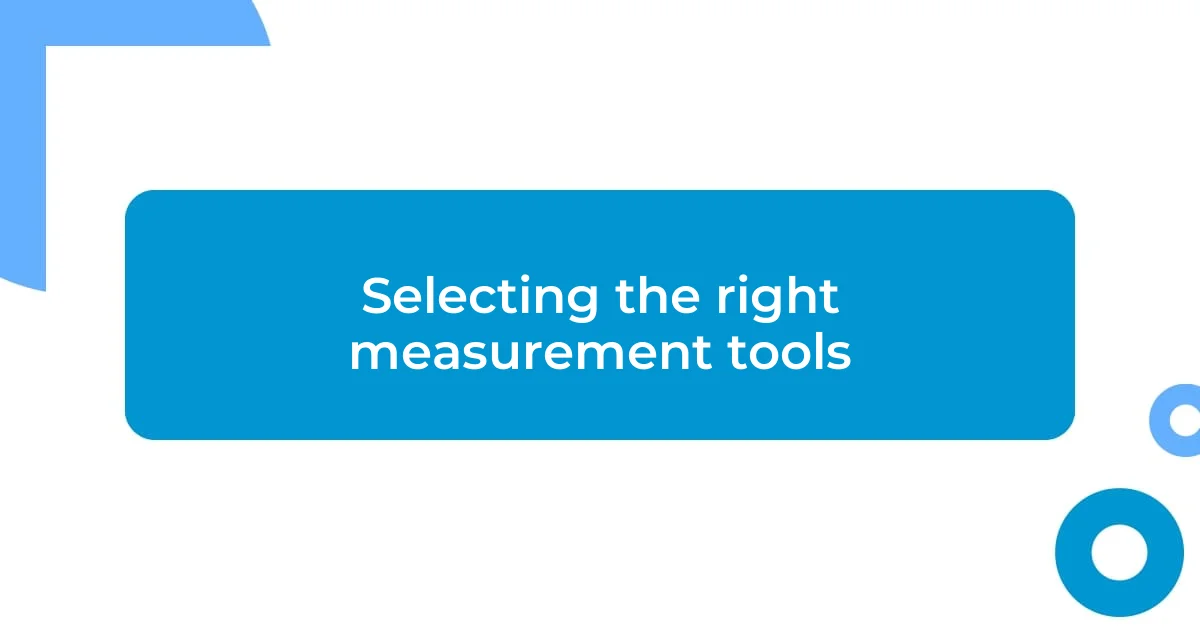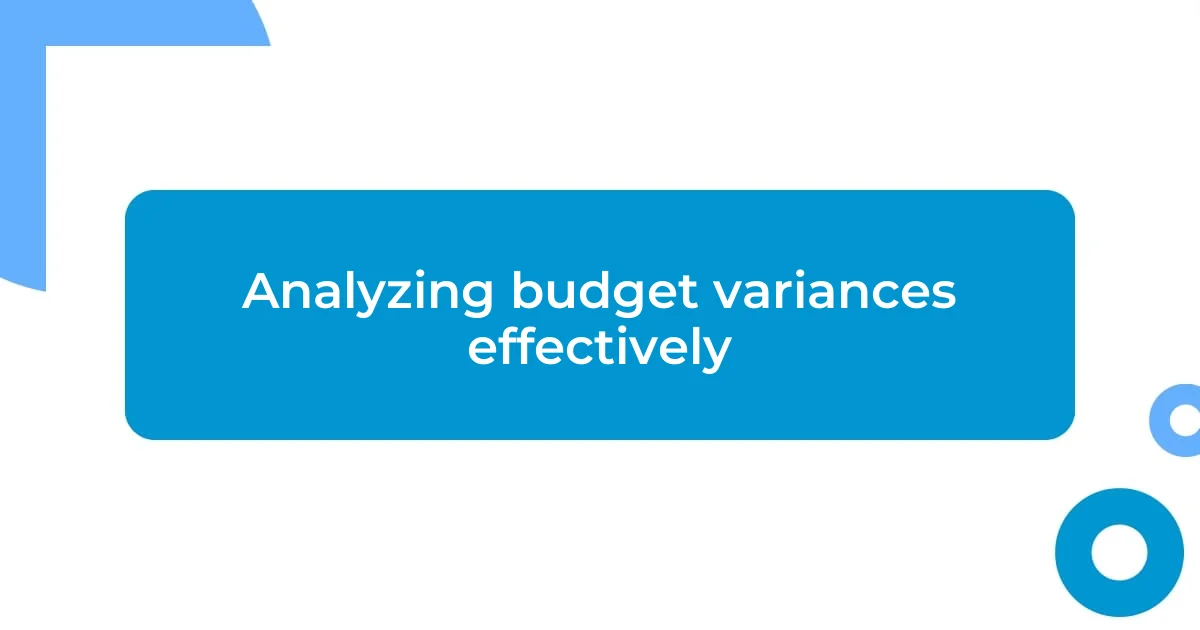Key takeaways:
- Variance analysis reveals opportunities for resource reallocation and strategic adjustments in budget management.
- Establishing clear, measurable performance goals fosters accountability and transforms budgeting into an engaging team effort.
- Regularly analyzing budget variances and encouraging collective brainstorming leads to improved financial outcomes and adaptability in planning.

Understanding budget performance metrics
When I first began measuring budget performance metrics, I found myself overwhelmed by the sheer volume of data. It occurred to me that it wasn’t just about numbers; it was about understanding how those numbers reflected our organization’s goals. Have you ever felt like drowning in spreadsheets? I certainly did, until I learned to focus on the key metrics that truly mattered.
One of the most impactful metrics I discovered was the variance analysis, which helped me examine the difference between planned budgets and actual spending. Surprisingly, this simple analysis revealed not just where we overspent but also where we might have underspent, allowing us to reallocate resources more effectively. Isn’t it fascinating how a metric can open your eyes to financial opportunities?
I also learned the value of tracking return on investment (ROI) for various projects. Every time we assessed a new initiative, I felt a surge of excitement to see how it would play out financially. The emotional journey of watching our investments either flourish or flop added a layer of engagement to budget management—making it not just a chore, but a crucial part of our strategy. Isn’t it rewarding to witness the tangible effects of your financial decisions?

Establishing performance measurement goals
Establishing performance measurement goals is essential for steering the organization towards its financial targets. I remember the first time I sat down with my team to define our goals—there was an energy in the room, a collective sense of purpose. We realized that clear, measurable objectives not only guided our spending but also informed our overall strategy. Here are a few key aspects we considered during that process:
- Align goals with organizational objectives to ensure cohesion.
- Set specific, measurable, achievable, relevant, and time-bound (SMART) criteria for each goal.
- Foster accountability by assigning responsibilities to team members.
I found that defining our goals was a blend of art and science. It required thoughtful consideration of both our aspirations and our capabilities. One memorable brainstorming session ended in laughter as we debated whether aiming for a 20% cost reduction was ambitious or unrealistic. Ultimately, we settled on a realistic yet challenging target that sparked motivation rather than fear. This balance was crucial; when team members feel ownership over their goals, it encourages a deeper commitment to achieving them. The focus we developed around performance measurement goals transformed our budgeting from a daunting task into an inspiring journey.

Selecting the right measurement tools
Selecting the right measurement tools can feel like a daunting task. I’ve been there, scrutinizing various tools and wondering which ones would best serve our needs. In my experience, a combination of both qualitative and quantitative tools has proven essential. For instance, while spreadsheets provide the raw data, project management software can offer those much-needed visual insights that help contextualize the numbers. Have you ever thought about how a simple dashboard can clarify complex data?
What has worked well for me is prioritizing user-friendly tools that the entire team can engage with. I recall when we first adopted a budgeting app; the learning curve was short, and soon, everyone was eagerly inputting their budget updates. The collective involvement not only fostered accountability but also transformed our meetings from tedious reviews into lively discussions filled with insights. That emotional investment in the tools we used made all the difference in how effectively we could assess our financial performance.
Ultimately, the tools we select should resonate with our unique organizational culture. Some prefer a straightforward approach, while others thrive on more interactive solutions. During our evaluations, we always made an effort to solicit feedback from team members, turning it into a collaborative process that left everyone feeling valued. This approach not only brought different perspectives to the table but also helped us choose tools that everyone felt comfortable using.
| Tool Type | Key Features |
|---|---|
| Spreadsheets | Customizable data manipulation and analysis |
| Budgeting Software | User-friendly interface with real-time updates |
| Project Management Tools | Visualization capabilities and team collaboration |

Analyzing budget variances effectively
Analyzing budget variances can uncover insights that are pivotal for effective financial management. I recall a specific instance when our actual spending on marketing fell short of our projections. Instead of panicking, we dove into the data, seeking reasons behind the variance. Was it due to unexpected costs or perhaps, an opportunity that slipped away? This deep dive helped us visualize patterns and trends, giving rise to adjustments that benefited future campaigns.
One approach that I found invaluable was breaking variances down into categories: favorable and unfavorable. On one occasion, I noticed that a particular project saved more than we anticipated, which allowed us to reallocate those funds. Have you ever experienced the thrill of reallocating surplus funds to an underperforming area? It’s almost like finding hidden treasure that breathes new life into your strategy! Understanding these distinctions helped my team and I maintain a clear focus on what to celebrate and what to improve.
Finally, I believe it’s key to hold regular variance analysis meetings. When my team and I began discussing variances in our monthly gatherings, we fostered a culture of continuous improvement. Each meeting felt like a team huddle where we celebrated our wins and tackled our challenges together. It transformed budget variance analysis from a mere number-crunching exercise into a dynamic conversation that built camaraderie and collective accountability. How has analyzing budget variances impacted your organization? For us, it wasn’t just about balancing the books; it became a learning journey that shaped our financial resilience.

Tracking ongoing performance indicators
Tracking ongoing performance indicators is crucial in understanding how well we’re sticking to our budgetary goals. I remember when we first integrated key performance indicators (KPIs) into our tracking process. Initially, it felt overwhelming—so many numbers and metrics swirling around. But, once we honed in on a few critical indicators, everything changed. Have you ever simplified a convoluted process only to discover newfound clarity? That’s exactly how it felt when we focused on our budget utilization and departmental spending efficiency.
One of the biggest revelations for me was the importance of real-time tracking. Observing how our expenses aligned with projected figures allowed for immediate adjustments. One month, I noticed an unusual spike in our operational costs, and it prompted a team discussion that led to actionable insights—like renegotiating supplier contracts. I often think back to that moment: without timely tracking, we might have missed the chance to optimize our spending and bolster savings. What would have happened if we had delayed addressing those rising costs? It reinforces my belief in being proactive rather than reactive.
I’ve also learned that it’s not just about the numbers; it’s about engaging the whole team in the performance tracking process. I initiated weekly check-ins where everyone shared their insights on KPI movements. This collaborative approach made everyone feel invested in the outcomes, and it transformed our tracking sessions into opportunities for brainstorming and problem-solving. Do you see how collective buy-in can amplify your budget management efforts? I truly believe that the more we acknowledged each team member’s contributions, the better we performed as a unit, ultimately leading to improved budget outcomes.

Reporting and communicating results
When it comes to reporting and communicating results, clarity is paramount. I’ve often found that the method we choose to present our budget performance can make or break the information’s impact. On one occasion, I designed a visual dashboard that provided a snapshot of our financial health at a glance. Have you ever noticed how a well-structured visual can convey a complex story more effectively than long reports? This approach not only helped my team stay aligned but also engaged stakeholders who might not have time for lengthy documents.
Another aspect I prioritize is the timing of our communications. Delivering results promptly after closing a financial period keeps everyone informed and ready to take action. I remember when we rushed to share preliminary findings after a quarter-end; the energy in the room was palpable as we analyzed what went well and where we could improve. It’s truly rewarding to see how timely communication fosters a culture of accountability. Do you think your team would react similarly if they received results immediately? I believe swift reporting inspires a sense of urgency that drives performance.
Furthermore, I always encourage feedback during our result communication sessions. Introducing an open forum where team members can voice their thoughts and questions has been transformative for us. One time, during a review meeting, a colleague shared insights about customer feedback that correlated with our spending—a revelation that reshaped our approach. Isn’t it fascinating how discussions can unearth insights we might overlook? I’ve learned that when we cultivate an environment where everyone feels heard, we unlock collective wisdom that propels us toward better financial decisions.

Adjusting plans based on findings
Adjusting plans based on our findings has been a game changer for me. When we discovered some departments consistently overspent, we quickly called a strategic huddle to understand the underlying causes. I’ll never forget the moment we unearthed that a lack of communication had led to duplicated purchases. Isn’t it interesting how a simple oversight can spiral into a significant budget blowout? We revamped our communication protocols, turning a potential crisis into an opportunity for collaboration and growth.
One time, after examining our quarterly results, I realized one project wasn’t delivering the anticipated ROI. It was a tough pill to swallow, but I knew we had to pivot. I proposed reallocating those resources to projects that showed promise. The relief on my team’s faces was palpable; they recognized the value in being flexible and responsive. Have you ever felt that exhilaration when making a tough decision that pays off in the long run? I’ve learned that embracing change, rather than fearing it, can lead to innovative solutions and enhanced outcomes.
Moreover, monitoring our budget performance revealed trends that prompted more extensive adjustments. For instance, when we noticed an uptick in digital marketing expenses, we took a step back to assess the campaign’s performance. Instead of blindly following trend reports, we opened the floor for ideas, and someone suggested enhancing our content strategy based on customer feedback. That single discussion reshaped our marketing approach, ultimately leading to a 20% increase in engagement. How often do you think we overlook the power of collective brainstorming? I can’t stress enough how being receptive to new ideas can fuel progress in our budgetary endeavors.














